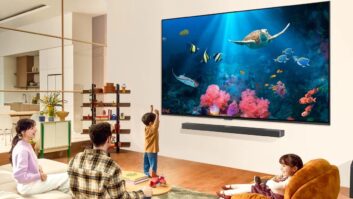Arlington, Va. – The
Consumer
Electronics Association
(CEA) issued a report Thursday detailing the
significant in size and weights of today’s flat-panel TVs compared to previous
CRT sets, indicating that e-waste recycling volume will diminish precipitously
as remaining CRT TVs in U.S. homes are replaced.
The report, titled “Materials Footprint Reduction of Televisions
and Computer Monitors: 2004-2010,” found flat-panel TVs are 82 percent lighter
and 75 percent smaller on average CRT TV predecessors of similar screen size.
The report also found current 40- to 70-inch flat-panel TVs weigh
34 percent less than 13- to 36-inch CRT TVs.
“The staggering reductions in materials in TVs and computer
monitors have real and lasting environmental benefits, from the supply chain
through recycling and disposal,” stated Walter Alcorn, CEA environmental
affairs and industry sustainability VP. “Dramatically lighter and smaller TVs
and monitors reduce the amount of resources needed to manufacture the product,
and slash the amount of required packaging and fuel used to transport these
products. Furthermore, the sunsetting of CRT TVs is vastly reducing the amount
of electronics to be recycled.”
The study, which was conducted by Pike Research under commission of
the CEA, underscores that manufacturing capacity for CRT products has plummeted
precipitously and will eventually fall to zero.
“Those CRT TVs and monitors represent the bulk of electronics
needed to be recycled in the coming years, and once most of those hefty TVs and
monitors reach end-of-life, the overall amount of electronic waste will decline,”
the CEA said.
The CEA coordinated eCycling Leadership Initiative, which has
targeted recycling 1 billion pounds of electronics annually by 2016, set measurement
and transparency as one of its key principles along with bolstering consumer
education of eCycling and increasing the number of recycling locations and
infrastructure needed to reach the one billion-pound annual target.
This report is the first of many technical reports on issues
relating to end-of-life electronics.
Additionally, while
consumer ownership of smartphones and tablets is on the rise, CEA’s 13th Annual
Household CE Ownership and Market Potential Study, which was released in May,
found that the number of discrete CE products per household declined to 24 this
year from 25 in 2010, in part because device functions are consolidating.
Smartphones and tablets represent a small fraction of the total
weight and volume of the electronics waste stream, including old CRT
televisions and monitors, the CEA said.
The Materials Footprint report found that while an old 36-inch
CRT TV generated about the same amount of electronics waste as 5,080 cell phones,
today’s 70-inch flat-screen TV generates the equivalent of just 953 cell
phones, and a 30-inch flat-panel computer monitor’s weight is equivalent to 211
mobile phones.
“The report illustrates a measurable, positive environmental
impact new technologies have made in reducing the materials footprint of
consumer electronics products,” Alcorn concluded. “We expect the trend of
ever-shrinking electronics to continue, whether it’s a 70-inch TV or a handheld
device.”
The Materials Footprint
report follows another study released by CEA in February that illustrated the
increased efficiency of TVs since 2003.













